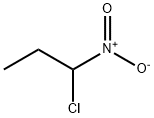Chloronitropropane is a flammable, colorlessliquid with an unpleasant odor that causes tears (lachrimator). Molecular weight =123.5; Specific gravity (H2O:1) =1.2; Boiling point =142.7℃; Vapor pressure =6 mmHg at25℃; Flash point =62℃ (oc). Hazard Identification (basedon NFPA 704 M Rating System): Health (unknown),Flammability 3, Reactivity 2. Slightly soluble in water;solubility =0.6% at 20℃
Chloronitroproane is a flammable, colorless
liquid with an unpleasant odor that causes tears (lachrymator).
Colorless liquid. Unpleasant odor.
Slightly soluble in water [Lawry's].
1-CHLORO-1-NITROPROPANE is sensitive to heat (may be explosive). 1-CHLORO-1-NITROPROPANE is incompatible with oxidizers. 1-CHLORO-1-NITROPROPANE will attack some forms of plastics, rubber and coatings . Combustible: May produce toxic gases, including nitrogen oxides, hydrogen chloride, and carbon monoxide. Will attack some plastics, rubber, and coatings [USCG, 1999].
LIQUID: Irritating to skin and eyes. Harmful if swallowed.
Combustible: May produce toxic gases, including nitrogen oxides, hydrogen chloride, and carbon monoxide. Will attack some plastics, rubber, and coatings.
Poison by ingestion,
subcutaneous, and possibly other routes.
Moderately toxic by inhalation. Causes
injury to kidneys, liver, and cardiovascular
system. Mutation data reported. Flammable
liquid when exposed to heat, flame (sparks),
and oxidizers. Moderately explosive when
exposed to heat. To fight fire, use alcohol
foam, water, CO2, or dry chemical. When
heated to decomposition it emits toxic
fumes of Cland NOx. See also other
chloropropane entries and CHLORIDES.
This compound is used in the synthetic rubber industry; as a component in rubber cements;
and as a fungicide.
If this chemical gets into the eyes, remove anycontact lenses at once and irrigate immediately for at least15 min, occasionally lifting upper and lower lids. Seek medical attention immediately. If this chemical contacts theskin, remove contaminated clothing and wash immediatelywith soap and water. Seek medical attention immediately. Ifthis chemical has been inhaled, remove from exposure,begin rescue breathing (using universal precautions, including resuscitation mask) if breathing has stopped and CPR ifheart action has stopped. Transfer promptly to a medicalfacility. When this chemical has been swallowed, get medical attention. Give large quantities of water and inducevomiting. Do not make an unconscious person vomit.Medical observation is recommended for 24�48 h afterbreathing overexposure, as pulmonary edema may bedelayed. As first aid for pulmonary edema, a doctor orauthorized paramedic may consider administering a corticosteroid spray.
Color Code—Blue: Health Hazard/Poison: Store ina secure poison location. Prior to working with 1-chloro-1-nitropropane you should be trained on its proper handling andstorage. Before entering confined space where 1-chloro-1-nitropropane may be present, check to make sure that anexplosive concentration does not exist. Store to avoid contactwith strong oxidizers (such as chlorine, bromine, and fluorine), since violent reactions occur. Store in tightly closedcontainers in a cool, well-ventilated area away from heat.Metal containers involving the transfer of this chemicalshould be grounded and bonded. Where possible, automatically pump liquid from drums or other storage containers toprocess containers. Drums must be equipped with self-closingvalves, pressure vacuum bungs, and flame arresters. Use onlynonsparking tools and equipment, especially when openingand closing containers of this chemical. Sources of ignition,such as smoking and open flames, are prohibited where thischemical is used, handled, or stored in a manner that couldcreate a potential fire or explosion hazard.
UN2810 Toxic liquids, organic, n.o.s., Hazard
Class: 6.1; Labels: 6.1-Poisonous materials, Technical
Name Required.
May form explosive mixture with air.
Strong oxidizers may cause a fire and explosion hazard.
May explode when exposed to heat.
Incineration (816C, 0.5-second
minimum for primary combustion; 1204C, 1.0 second for
secondary combustion) after mixing with other fuel. The formation of elemental chlorine may be prevented by injection
of steam or using methane as a fuel in the process.
Alternatively it may be poured over soda ash, neutralized
and flushed into the sewer with large volumes of water.
